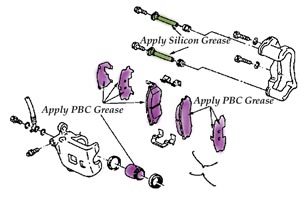By Larry Carley
Technical Editor
According to a recent BRAKE & FRONT END magazine survey, the most commonly replaced ABS items are wheel speed sensors and wheel bearing hub units with wheel speed sensors. Pulling a wheel speed sensor code does not mean that you should immediately pull and replace the sensor. If you do not confirm the source of the code, you are doomed to have a comeback.
You can check virtually any magnetic wheel speed sensor by measuring its resistance with an ohmmeter, but you need to look up the exact specifications for the vehicle because they can vary significantly from one application to another. For instance, older Toyota Camrys and Porsches both use a similar Bosch 2 ABS system. Yet the specs for the rear-wheel sensors on the Toyota are 900 to 1,200 ohms versus 1,600 to 1,800 ohms for the Porsche. Why? Who knows. But if the wheel speed sensor is out of specification, it won’t produce an accurate signal that the ABS control module can read.
Magnetic wheel speed sensors generate an alternating current (AC) signal that increases in frequency and amplitude as wheel speed increases. Because the sensors are magnetic, they can attract metallic debris from semi-metallic brake linings and rotors that stick to the tip and interfere with the signal. If the ABS module doesn’t see a clean wheel speed sensor signal, it may think there’s something wrong and set a wheel speed sensor code. Even a tiny nick in the tone ring around the outer CV joint or on the rotor may be enough to disrupt the signal.
 The distance or “air gap” between the end of a wheel speed sensor and its ring is critical. A close gap is necessary to produce a strong, reliable signal. You don’t want metal-to-metal contact between the sensor and its ring since it would damage both. But you don’t want too much clearance either. An air gap that’s too wide may produce a weak or erratic signal or, worse yet, no signal at all. So if a wheel speed sensor is adjustable (many are not), refer to the service literature for the required air gap and adjust it to specs. Insert a nonmagnetic brass or plastic feeler gauge between the end of the sensor and ring, and then tighten the set screw that locks the sensor in place.
The distance or “air gap” between the end of a wheel speed sensor and its ring is critical. A close gap is necessary to produce a strong, reliable signal. You don’t want metal-to-metal contact between the sensor and its ring since it would damage both. But you don’t want too much clearance either. An air gap that’s too wide may produce a weak or erratic signal or, worse yet, no signal at all. So if a wheel speed sensor is adjustable (many are not), refer to the service literature for the required air gap and adjust it to specs. Insert a nonmagnetic brass or plastic feeler gauge between the end of the sensor and ring, and then tighten the set screw that locks the sensor in place.
Some sensors come with a piece of paper or plastic over the end that provides just the right gap when the sensor is installed. To install this type of sensor, insert it until it just touches the sensor ring, then backed off just enough so the ring will turn without rubbing against the spacer. Tightening the set screw locks it in place.
A good wheel speed sensor will generally produce an AC voltage reading of 50 to 700 MV when the wheel is spun at a speed of about one revolution per second. Use a digital multimeter or a digital storage oscilloscope to check the sensor’s output.
If the voltage reading is low or nonexistent, check the sensor’s resistance (with the key off). You can do this at the wheel or by using a breakout box in the ABS module wiring harness. Measuring at the harness will also check the continuity of the circuit. If you get a low reading at the harness, check the wheel speed sensor. If the sensor is within specs (typically 800 to 1,800 ohms), the problem is in the wiring, not the sensor.
If you’re using a scope to check a wheel speed sensor circuit, a signal pattern that is flattened (diminished amplitude) or erratic usually indicates a weak signal caused by an excessively wide air gap between the tip of the sensor and its ring, or a buildup of metallic debris on the end of the sensor. A weak signal can also be caused by internal resistance in the sensor or its wiring circuit, or from loose or corroded wiring connectors.
One new piece of hardware that is being used on certain Chrysler ABS systems (trucks mostly, but LH cars in 2004) as well as the Lincoln LS is an “active” Hall effect wheel speed sensor. Most wheel speed sensors are magnetic (variable reluctance), but the new Hall effect sensor generates a stronger square wave signal that allows the system to more accurately monitor wheel velocity at low speeds. The sensors have two wires and use the chassis as ground.
My Light is On
The ABS warning light is on in your customer’s car and he wants you to check it out. So where do you start your diagnosis? Because the ABS warning light is on, you know the ABS system has detected some kind of fault. But are there other problems that may be affecting the ABS system? Start your diagnosis by asking your customer a few questions. How long has the warning light been on? Has the warning light been on before? Have you noticed any other problems with the brakes? Has the brake warning light or any other warning lights been on recently? Have you had the vehicle serviced recently?
Depending on what kind of answers you get, you may want to investigate some other things before you plug in your scan tool to read the ABS fault code(s). If the check engine light or charging system warning light has been on, the vehicle might have a low voltage problem that is affecting the ABS system. And if the customer says he had the tires replaced a few days ago, the ABS warning light might be on because of a change in tire size, mismatched tire sizes, a severely underinflated tire or even a damaged wire to a wheel speed sensor.











